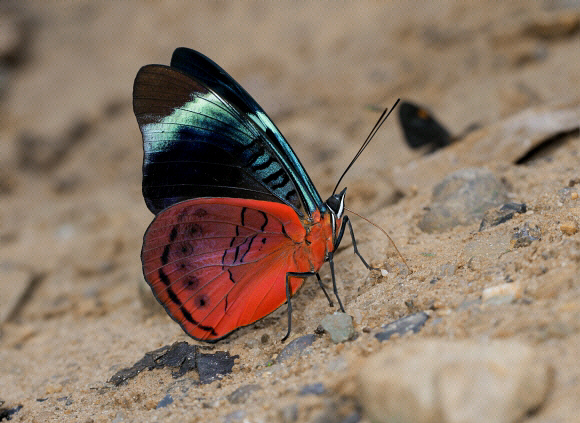 Panacea regina regina male, Manu, Madre de Dios, Peru – Adrian Hoskins
Panacea regina regina male, Manu, Madre de Dios, Peru – Adrian Hoskins
Introduction
The genus Panacea contains 3 species, all confined to the neotropics. They are all characterised by having blackish uppersides with extensive iridescent blue / turquoise markings.
The underside hindwings of all Panacea species are reddish. In procilla the ground colour is reddish brown, overlaid with broken wavy black lines and a series of submarginal ocelli. It also has reddish maculae in the forewing discal cell. In prola the underside is bright red and without ocelli. Both prola and procilla have red maculae in the underside fw discal cell, but these are absent in regina.
Panacea regina is the largest member of the genus. It was discovered by the legendary explorer and naturalist Henry Walter Bates, and named in honour of Queen Victoria ( Victoria regina ).
It often shares its breeding sites with Panacea prola, but is always outnumbered by that species. It differs from prola on the upperside hindwing in having a row of suffused dark submarginal spots and a thin dark wavy line that terminates close to the tornus.
Panacea regina is found across much of Amazonia from Colombia to Peru and southern Brazil.
 Panacea regina regina male, Satipo, Peru – Adrian Hoskins
Panacea regina regina male, Satipo, Peru – Adrian Hoskins
Habitats
Like prola, this species appears to be confined to lowland rainforests at altitudes below about 800m.
Lifecycle
The lifecycle and larval foodplants are apparently unknown.
 Panacea regina regina, Satipo, Peru – Adrian Hoskins
Panacea regina regina, Satipo, Peru – Adrian Hoskins
Adult behaviour
The butterflies roost amongst foliage high in the forest canopy. In the early morning they can be seen basking on tree trunks at a height of about 10-15m, head downwards, with wings flattened against the bark of the tree.
As temperatures begin to climb and light levels increase, they gradually descend to bask at lower points on the trunk, but will fly back to bask much higher up if disturbed. Later, even the weather remains cool and overcast, they descend to settle on riverbanks, often settling on rocks, stones, or logs. Once the butterflies have been on the ground for a few minutes they become very reluctant to move, and will remain basking until dusk, even during light showers or drizzle.

Panacea regina regina Satipo, Peru – Adrian Hoskins
Males gather in mixed aggregations with Panacea prola, basking with wings outstretched. They are constantly alert to intruders, and when one individual detects a threat from an approaching bird or human, it responds by fanning it’s wings to display the bright red underside. This acts as a signal to warn its brethren, who also start fanning their wings, so that the whole group very quickly becomes alerted to the danger and is ready to fly up into the trees to escape.

Panacea regina regina, Satipo, Peru – Adrian Hoskins
